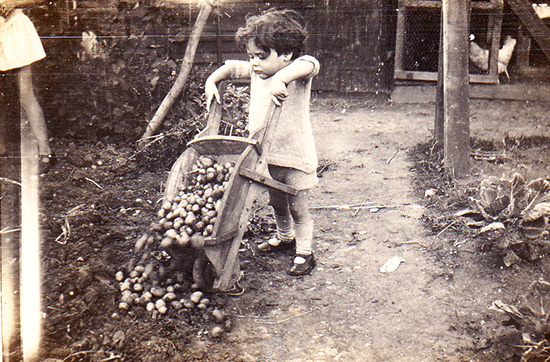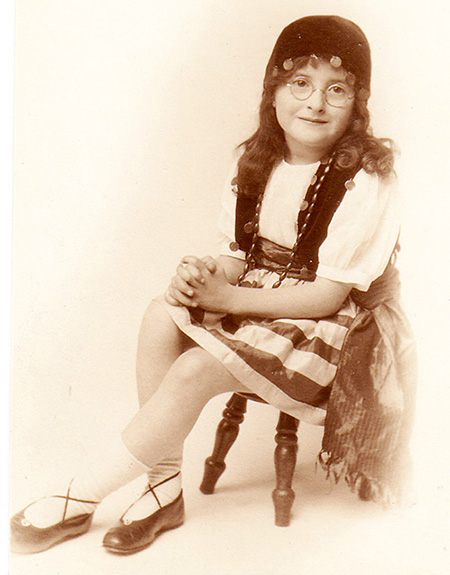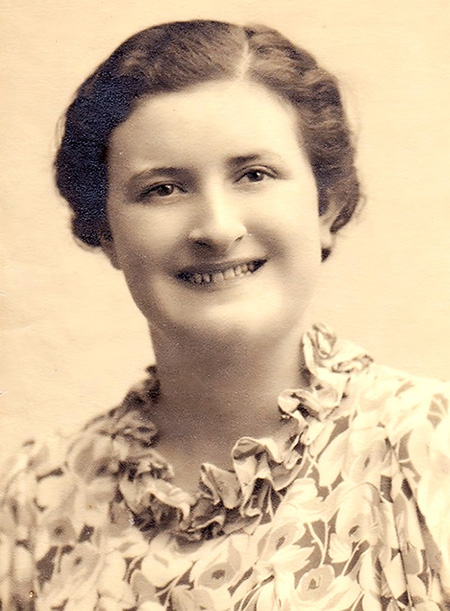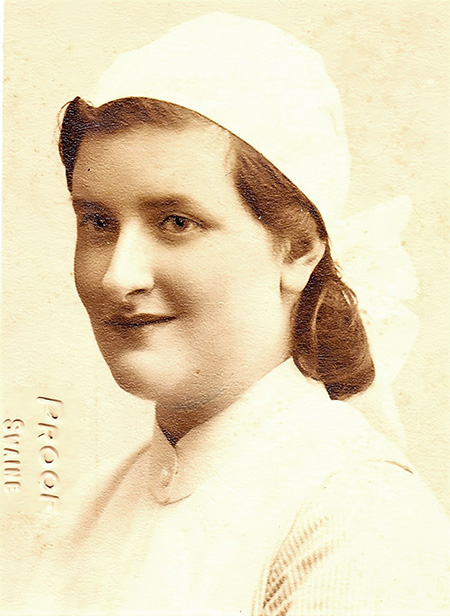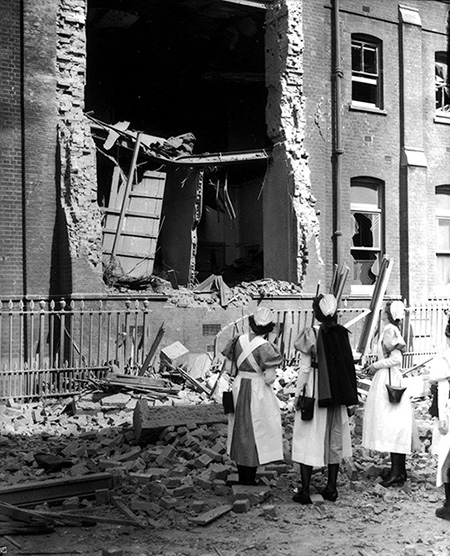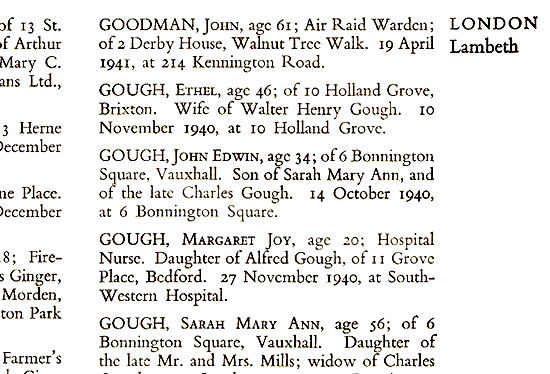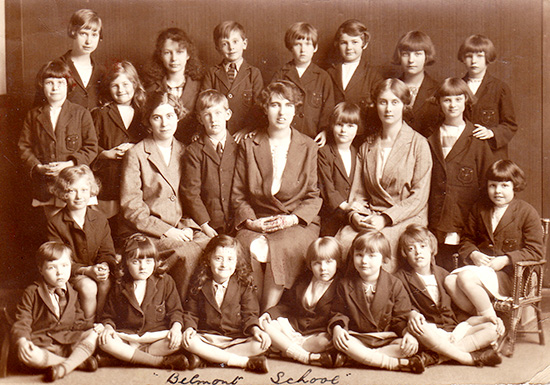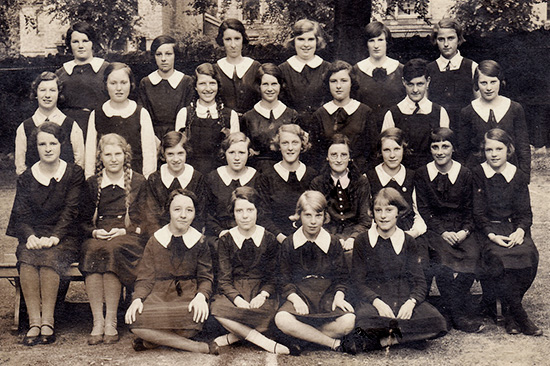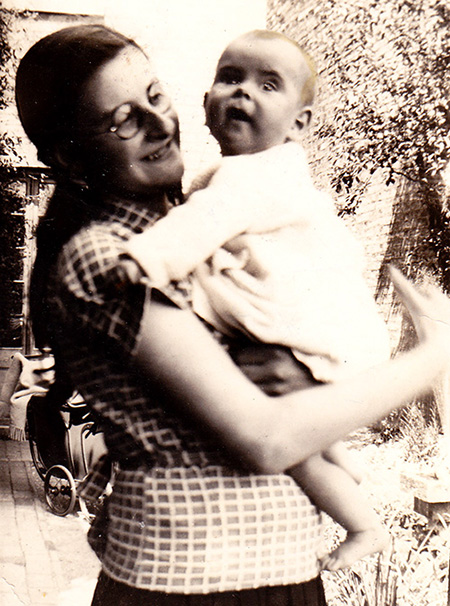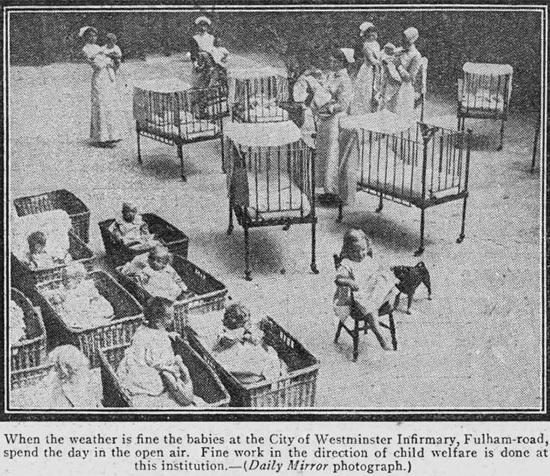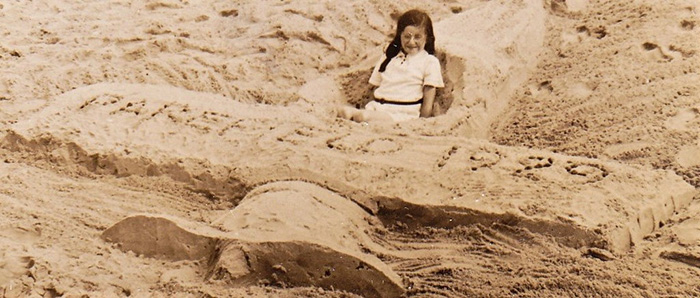
Joy's father made a sand sculpture every Summer holiday. Sometimes boats, sometimes planes, but never sand castles
Joy Gough
Age 2. Joy deliberately spills a wheelbarrow full of onions (or apples?). This photo was labelled 'Mischief' in the family album
Alfred and Rosie chose such an appropriate name for their adopted daughter. On her original adoption certificate she was Marguerite. But within a few weeks of taking the 8-month old home, they had decided on a middle name 'Joy', the preferred name for all those who knew her.
I never met my Aunt Joy and can only write this after reading a few letters she sent home while nursing, and those sent by others when she died in the early years of the war. 'We'll miss her grand personality' says one person after she died, 'so loveable' says another. She certainly looks comfortable, mischievous, gregarious, and always smiling in the photos taken of her.
My mother Rosemary, her sister, said that she was, in fact, a little jealous that Joy was so confident, outgoing and popular. Whereas Rosemary's school teacher described Mum at the time, as a 'thoughtful, steady little soul'. More like her father, Alfred really.
Joy started off her junior school days at Belmont School and then moved, aged 6, to the Convent of the Holy Ghost, in Bromham Road, Bedford. This was an all-girls Catholic school and she was taught by the Sisters there. She got on well with several of the nuns and kept in touch with them even after she had left the Convent.
Joy was less interested in the academic side of studies and preferred singing and dancing, especially country dancing. She became an older sister when Rosemary was born in 1933, and then in 1938 took the decision to go into nursing.
Joy did her first six months' probation at St Charles Hospital in Ladbroke Grove, London. It was the first time that she had been away from home and she wrote a four page letter that gave them a snapshot into her new working life.
Even though this was before the war, Joy will undoubtedly have left out things that might have upset them. However, she does lay out the framework of a nurse probationer (3 years' training) which seem quite strict and stringent today. She did a 13 hour day with one day off a month and a half day every other Sunday. Off duty, she had to be back in the Nurses' Home by 10.30pm, though a late pass would allow you to return by 1.30am.
There was usually no heating in the nurses' quarters and so during the winter they'd gather together in a crowded common room where a fire was lit. Some had to dive under the bed covers to keep warm while they wrote home. Joy notes in her last letter home in November 1940, that the Irish nurses had not been home for 20 months but were finally being allowed to have two weeks' leave in the New Year.
When the war started, the conditions became even tougher for nurses, as Blitz casualties could come in at any time. If the ward was still busy, she'd (all nurses were women) lose her free time. The Civil Defence teams would look after lesser injuries on site, and those that went to hospital had more extreme injuries, being crushed under a falling building or being cut by flying glass.
It was not a job for the faint-hearted and Joy became more resilient, but never lost her compassion. Her Irish friend and colleague, Margaret Gallagher, said Joy "was always sympathising with everyone else with their sorrows".
When the Blitz started on 7th September 1940, so began 57 consecutive days of bombing in London. In November, Joy writes from South Western Hospital, Lambeth,"They removed our bomb on Friday, to our very great relief. It was awful having it here. The M.S. collected £5.17.4 for the removal squad and made it up to £10.00 himself. They really do deserve it. You should see the speed with which they work. It is quite a common sight to see a lorry rushing along with an unexploded bomb on it. How the traffic moves, and everyone runs in doorways."
Did Joy find love in her short life? In her last letter home she wrote"...I don't dislike the romper [one-piece] suit quite as much as I did. Harry looks rather nice in his. We had an awful quarrel on Thursday but this morning I had a glorious bunch of yellow and gold chrysanthemums sent in from him so shall go down to the unit at 8.15pm."
Harry came to Joy's funeral in Bedford. He didn't give his surname and the local newspaper listing the chief mourners marked him down as "'Harry' (mobile)". He could have been one of the Americans at the American Mobile Unit based near the hospital.
T he 27th November 1940, was a busy day for Joy. She had done a day's work and then went to her friend Margaret Gallagher's 21st birthday party. Margaret writes "She wore her big green coat, and her little red one with a black skirt underneath and we talked for some time. She wished me 'Many Happy Returns' for about the 80th time that day, Joy laughing in the moonlight and wishing me luck as I went out of the hospital grounds."
When Margaret went back, the gate porter told her the dreadful news that the hospital had been bombed. She wrote to Alfred and Rosie "Joy was always full of life and vigour, the life of every crowd... she would like me to let you know that she suffered no pain and that the end was as swift as lightning flash and therefore quite painless... and is now enjoying the fruits of her goodness in the next world."
A Luftwaffe bomb killed Joy and injured two other nurses at the South Western Hospital that night. Joy, knew that she had been given up for adoption, but also knew that she had been 'chosen' and lovingly brought up by Alfred and Rosie. She wrote to them from London at the beginning of her nurse probation, signing off her letter:"I'm dying to see you two dear creatures. I never realised I could love anyone so much as I do you. Lovingly Joy xxx"
Joy is listed in the Commonwealth Graves Roll of Honour for civilian deaths by enemy action in Britain during WW2
Joy also seems to have been adored by those close to her, and she knew how to balance working hard and having fun.
Neither my brother nor I, ever got to meet our Aunty Joy, and that is our loss. The last time I went to Westminster Abbey, I looked through the pages in the Commonwealth Graves Roll of Honour commemorating the 66,000 civilians who died from enemy action in the UK and left Joy's page open. I will ensure that when I next visit, that the book is left open on Margaret Joy Gough's page once more.
